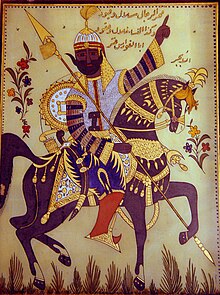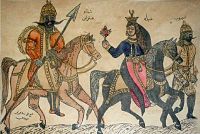Antarah ibn Shaddad
Antarah ibn Shaddad عنترة بن شداد | |
|---|---|
| عنترة بن شداد العبسي | |
 | |
| Born | ʿAntarah ibn Shaddād al-ʿAbsī 525 AD |
| Died | 608 (aged 82–83) AD |
| Era | Pre-Islamic Arabia |
| Region | Al Jiwa, Ancient Arabia, Arab world |
Main interests | Arabic poetry |
Antarah ibn Shaddad al-Absi (Arabic: عنترة بن شداد العبسي), ʿAntarah ibn Shaddād al-ʿAbsī; AD 525–608), also known as ʿAntar, was a pre-Islamic Arabian poet and knight, famous for both his poetry and his adventurous life. His chief poem forms part of the Mu'allaqāt, the collection of seven "hanging odes" legendarily said to have been suspended in the Kaaba at Mecca. The account of his life forms the basis of a long and extravagant romance.
Life
[edit]

ʿAntarah was born in Najd in the Arabian Peninsula. His father was Arab, Shaddād al-ʿAbsī, a respected warrior of the Banu Abs under their chief Zuhayr.[1] His mother was an Ethiopian woman named Zabībah.[2] Described as one of three "Arab crows" (Aghribah al-'Arab) - famous Arab with a black complexion,[3]ʿAntarah grew up a slave as well. He fell in love with his cousin ʿAblah, but could not hope to marry her owing to his position.[1] He also gained the enmity of his father's wife Sumayya.[1]
He gained attention and respect for himself by his personal qualities and courage in battle, excelling as an accomplished poet and a mighty warrior. He earned his freedom after another tribe invaded the lands of the Banu ʿAbs. When his father said to him, "ʿAntarah, fight with the warriors", he replied that "the slave doesn't know how to invade or how to defend, but is only good for milking goats and serving his masters". His father answered him: "Defend your tribe, O ʿAntar, and you are free". After defeating the invaders, he sought to gain permission to marry his cousin. To secure allowance to marry, Antarah had to face challenges including getting a special kind of camel from the Northern Arab Lakhmid Kingdom, then under al-Nu'man III ibn al-Mundhir. ʿAntarah took part in the great war between the related tribes of ʿAbs and Dhubyān,[2] which began over a contest of horses, and was named after them the war of Dāhis and Ghabrā.
The time and manner of his death are a matter of dispute. Ibn Duraid has him slain by Wasr ibn Jabir[1] or in battle against the Tayy,[2] while according to Abu Obeida he died a natural death in old age.[1]
ʿAntarah's poetry is well preserved and often talks of chivalrous values, courage, and heroism in battle as well as his love for ʿAbla. It was immortalized when one of his poems was included in the Mu'allaqat, the collection of poems legendarily said to have been suspended in the Kaaba.[1] His poetry's historical and cultural importance stems from its detailed descriptions of battles, armour, weapons, horses, desert, and other themes from his time.
Legacy
[edit]
The story of ʿAntar and ʿAbla was embroidered into a poetic saga traditionally credited to al-Asmaʿi, a poet in the court of Hārūn al-Rashīd.[1] It is still recited by traditional story-tellers in Arab coffee houses. Its importance has been compared with English literature's Arthurian romances.[1] His house and his stable were particularly legendary.[1] One of the seven clans of Bethlehem is called the Anatreh, named after ʿAntarah. It formerly acted as the guardians of the Church of the Nativity.
The Russian composer Nikolai Rimsky-Korsakov wrote his Symphony No. 2 based on the legend of ʿAntar. In 1898 the French painter Étienne Dinet published[4] his translation of a 13th-century epic Arab poem Antar, which brought Antar bin Shaddad to European notice.[4] It has been followed by a number of derivative works such as Diana Richmond's Antar and Abla[5] which furthered western exposure to the Antar bin Shaddad legends. "Antar" is the title of the first Palestinian opera, composed by the Palestinian musician Mustapha al-Kurd in 1988.
The Lebanese painter Rafic Charaf developed from the 1960s a series of paintings depicting the epics of Antar and Abla. These works that show his interest in the popular folklore of the region are considered a cornerstone in the artist's work.[6]
In the late 1940s the British Lorry Manufacturer Thornycroft began the design of an oilfield tractor to carry pipes for the Anglo-Persian Oil Company which later became the Anglo-Iranian Oil Company. The chosen name for the new Thornycroft tractor, which at the time was one of the largest tractors in the world, was the Thornycroft Mighty Antar. The Antar moniker was chosen with reference to the mighty Warrior Antar.
Works
[edit]Antara's poems are published in Wilhelm Ahlwardt's The Divans of the six ancient Arabic poets (London, 1870); they have also been published separately at Beirût (1888). As regards their genuineness, cf. W. Ahlwardt's Bemerkungen über die Aechtheit der alten arabischen Gedichte (Greifswald, 1872), pp. 50ff. The Romance of 'Antar (Sīrat 'Antar ibn Shaddād) is a work which was long handed down by oral tradition only; it has grown to immense proportions and has been published in 32 vols. at Cairo (1889), and in 10 vols. at Beirût, 1871. It was partly translated by Terrick Hamilton under the title 'Antar, a Bedoueen Romance (4 vols, London, 1820).[2] In addition, Sīrat 'Antar was translated into Turkish by the order of Fatih Sultan Mehmed in 1477 AD.[7] The translator of the Turkish translation in three volumes is unknown. The manuscript copies of the Turkish translation known as "Qıssa-i 'Antar" are available in the Topkapı Palace Museum Library.
See also
[edit]- Arabic literature & romance literature
- Banu Abs
- Thornycroft Antar - British pipeline tractor named after his strength and endurance
Notes
[edit]- ^ a b c d e f g h i EB (1878).
- ^ a b c d EB (1911).
- ^ Lewis 1992, p. 28.
- ^ a b Pouillon, Francois (1997), Les deux vies d'Étienne Dinet, peintre en Islam: L'Algerie et l'heritage colonial, Paris: Editions Balland.
- ^ Richmond, Diana (1978), Antar and Abla: a Bedouin romance, London: Quartet Books, ISBN 0-7043-2162-9.
- ^ "Rafic Charaf". The Mokbel Art Collection. 2011. Retrieved 18 February 2012.
- ^ İkbâl GÜLER, Muhammed (2020-01-01). "Kissa-İ Anter: Topkapi Sarayi Müzesi̇ Kütüphanesi̇'ndeki̇ el Yazmasi Nüshalarin Tanitimi Ve Değerlendi̇ri̇lmesi̇". International Journal of Turkish Literature Culture Education. 9 (9/1): 48–79. doi:10.7884/teke.4620. ISSN 2147-0146.
References
[edit]- Baynes, T. S., ed. (1878), , Encyclopædia Britannica, vol. 2 (9th ed.), New York: Charles Scribner's Sons, p. 100
- Lewis, Bernard (1992). Race and Slavery in the Middle East: An Historical Enquiry. Oxford University Press. p. 28. ISBN 978-0-19-505326-5.
Attribution
- This article incorporates text from a publication now in the public domain: Thatcher, Griffithes Wheeler (1911), "'Antara ibn Shaddād", in Chisholm, Hugh (ed.), Encyclopædia Britannica, vol. 2 (11th ed.), Cambridge University Press, pp. 88–89
